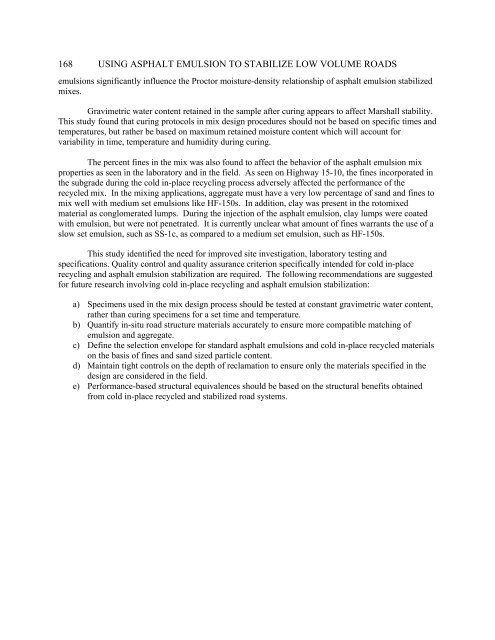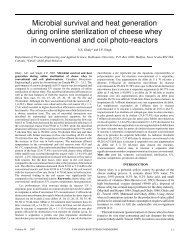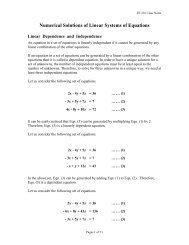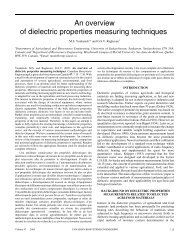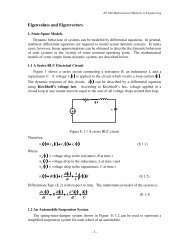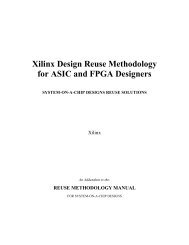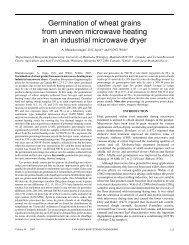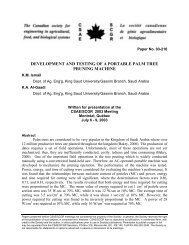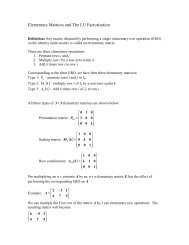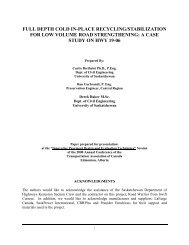Cold-In-Place Recycling using Asphalt Emulsion for Stabilization of ...
Cold-In-Place Recycling using Asphalt Emulsion for Stabilization of ...
Cold-In-Place Recycling using Asphalt Emulsion for Stabilization of ...
You also want an ePaper? Increase the reach of your titles
YUMPU automatically turns print PDFs into web optimized ePapers that Google loves.
168 USING ASPHALT EMULSION TO STABILIZE LOW VOLUME ROADS<br />
emulsions significantly influence the Proctor moisture-density relationship <strong>of</strong> asphalt emulsion stabilized<br />
mixes.<br />
Gravimetric water content retained in the sample after curing appears to affect Marshall stability.<br />
This study found that curing protocols in mix design procedures should not be based on specific times and<br />
temperatures, but rather be based on maximum retained moisture content which will account <strong>for</strong><br />
variability in time, temperature and humidity during curing.<br />
The percent fines in the mix was also found to affect the behavior <strong>of</strong> the asphalt emulsion mix<br />
properties as seen in the laboratory and in the field. As seen on Highway 15-10, the fines incorporated in<br />
the subgrade during the cold in-place recycling process adversely affected the per<strong>for</strong>mance <strong>of</strong> the<br />
recycled mix. <strong>In</strong> the mixing applications, aggregate must have a very low percentage <strong>of</strong> sand and fines to<br />
mix well with medium set emulsions like HF-150s. <strong>In</strong> addition, clay was present in the rotomixed<br />
material as conglomerated lumps. During the injection <strong>of</strong> the asphalt emulsion, clay lumps were coated<br />
with emulsion, but were not penetrated. It is currently unclear what amount <strong>of</strong> fines warrants the use <strong>of</strong> a<br />
slow set emulsion, such as SS-1c, as compared to a medium set emulsion, such as HF-150s.<br />
This study identified the need <strong>for</strong> improved site investigation, laboratory testing and<br />
specifications. Quality control and quality assurance criterion specifically intended <strong>for</strong> cold in-place<br />
recycling and asphalt emulsion stabilization are required. The following recommendations are suggested<br />
<strong>for</strong> future research involving cold in-place recycling and asphalt emulsion stabilization:<br />
a) Specimens used in the mix design process should be tested at constant gravimetric water content,<br />
rather than curing specimens <strong>for</strong> a set time and temperature.<br />
b) Quantify in-situ road structure materials accurately to ensure more compatible matching <strong>of</strong><br />
emulsion and aggregate.<br />
c) Define the selection envelope <strong>for</strong> standard asphalt emulsions and cold in-place recycled materials<br />
on the basis <strong>of</strong> fines and sand sized particle content.<br />
d) Maintain tight controls on the depth <strong>of</strong> reclamation to ensure only the materials specified in the<br />
design are considered in the field.<br />
e) Per<strong>for</strong>mance-based structural equivalences should be based on the structural benefits obtained<br />
from cold in-place recycled and stabilized road systems.


